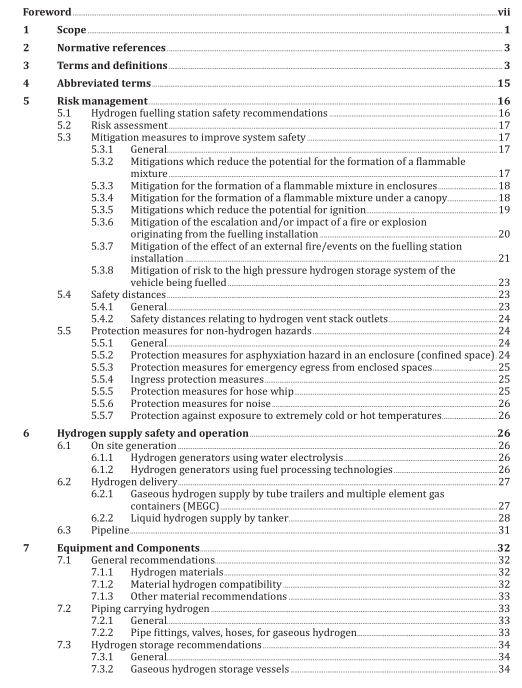ISO 19880-1:2020 pdf download.Gaseous hydrogen — Fuelling stations — General requirements
This document defines the minimum design, installation, commissioning, operation, inspection and maintenance requirements, for the safety, and, where appropriate, for the performance of public and non-public fuelling stations that dispense gaseous hydrogen to light duty road vehicles (e.g. fuel cell electric vehicles).
This document is not applicable to the dispensing of cryogenic hydrogen, or hydrogen to metal hydride applications.
Since this document is intended to provide minimum requirements for fuelling stations, manufacturers can take additional safety precautions as determined by a risk management methodology to address potential safety risks of specific designs and applications.
While this document is targeted for the fuelling of light duty hydrogen road vehicles, requirements and guidance for fuelling medium and heavy duty road vehicles (e.g. buses, trucks) are also covered.
Many of the generic requirements within this document are applicable to fuelling stations for other hydrogen applications, including but not limited to the following:
— fuelling stations for motorcycles, fork-lift trucks, trams, trains, fluvial and marine applications;
— fuelling stations with indoor dispensing;
— residential applications to fuel land vehicles;
— mobile fuelling stations; and
— non-public demonstration fuelling stations.
However, further specific requirements that can be necessary for the safe operation of such fuelling stations are not addressed in this document.
This document provides requirements for and guidance on the following elements of a fuelling station (see Figure 1 and Figure 2):
— hydrogen production/delivery system:
— delivery of hydrogen by pipeline, trucked in gaseous and/or liquid hydrogen, or metal hydride storage trailers;
— on-site hydrogen generators using water electrolysis process or hydrogen generators using fuel processing technologies;
— liquid hydrogen storage;
— hydrogen purification systems, as applicable;
— compression:
— gaseous hydrogen compression;
— pumps and vaporizers;
— gaseous hydrogen buffer storage;
— pre-cooling device;
— gaseous hydrogen dispensing systems.
2 Normative references
The following documents are referred to in the text in such a way that some or all of their content constitutes requirements of this document. For dated references, only the edition cited applies. For undated references, the latest edition of the referenced document (including any amendments) applies
ISO 13850, Safety of machinery — Emergency stop function — Principles for design
ISO 14687, Hydrogen fuel — Product specification
ISO 15649, Petroleum and natural gas industries — Piping
ISO 17268, Gaseous hydrogen land vehicle refuelling connection devices
ISO 19880-8, Gaseous hydrogen — Fuelling stations — Part 8: Hydrogen quality control
ISO 21013-1, Cryogenic vessels — Pressure-relief accessories for cryogenic service — Part 1: Reclosable pressure-relief valves
ISO 21013-2, Cryogenic vessels — Pressure-relief accessories for cryogenic service — Part 2: Non-reclosable pressure-relief devices
ISO 21013-3, Cryogenic vessels — Pressure-relief accessories for cryogenic service — Part 3: Sizing and capacity determination
ISO 22734, Hydrogen generators using water electrolysis
ISO/IEC 80079 (all parts), Explosive atmospheres
IEC 60079 (all parts), Explosive atmospheres
IEC 60204-1:2005, Safety of machinery — Electrical equipment of machines — Part 1: General requirements
IEC 60529, Degrees of protection provided by enclosures (IP Code)
IEC 62282-3-100, Fuel cell technologies. Stationary fuel cell power systems. Safety
EN 13445-5, Unfired pressure vessels. Inspection and testing
SAE J2600: 2015-08, Compressed Hydrogen Surface Vehicle Fuelling Connection Devices
3 Terms and definitions
For the purposes of this document, the following terms and definitions apply.
ISO and IEC maintain terminological databases for use in standardization at the following addresses:
— ISO Online browsing platform: available at https:// www .iso .org/ obp
— IEC Electropedia: available at http:// www .electropedia .org/
3.1 acceptance criteria
<risk or harm > acceptable level of risk or harm (3.34), locally defined as:
— a tolerable risk value; or
— a specified harm level; or
— requirements in a prescriptive document
3.2 accessory
device with an operational function
3.3 bleed
<venting> intentional expiration of a fluid from a fluid system
3.4 basic process control system
BPCS
system which responds to input signals from the process, its associated equipment, other programmable systems and/or an operator and generates output signals causing the process and its associated equipment to operate in the desired manner but which does not perform any safety-instrumented functions with a claimed SIL (3.73) ≥ 1.ISO 19880-1 pdf download.ISO 19880-1 pdf download
